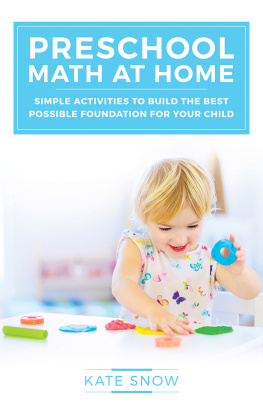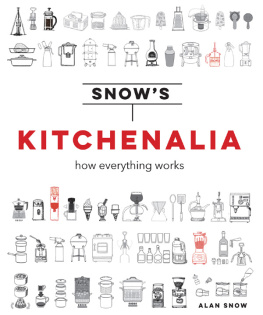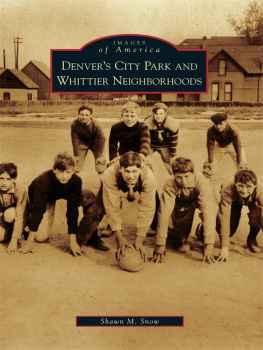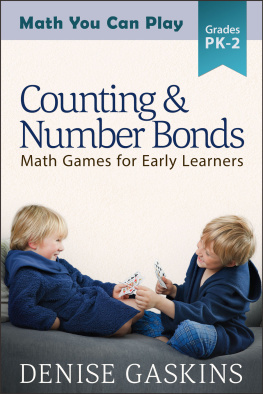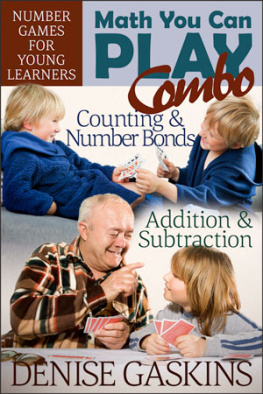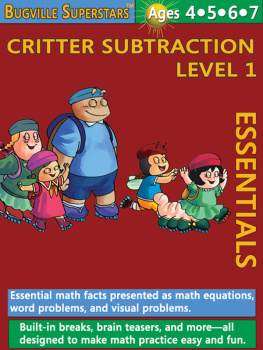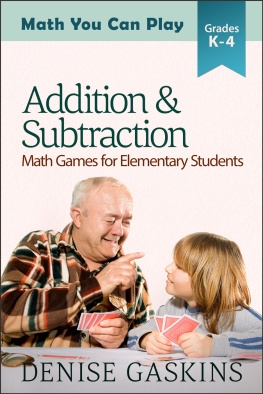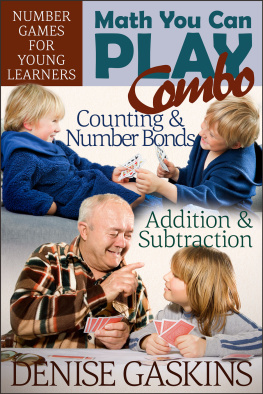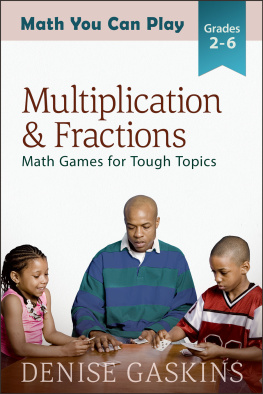

Copyright 2016 Well-Trained Mind Press
All rights reserved.
Publishers Cataloging-In-Publication Data
(Prepared by The Donohue Group, Inc.)
Names: Snow, Kate.
Title: Preschool math at home : simple activities to build the best possible foundation for your child / Kate Snow.
Description: Charles City, VA : Well-Trained Mind Press, [2016]
Identifiers: LCCN 2016930340 | ISBN 978-1-933339-91-7
Subjects: LCSH: Counting--Study and teaching (Preschool) | Numbers, Natural-Study and teaching (Preschool) | Arithmetic--Study and teaching (Preschool) | Educational games.
Classification: LCC QA135.6 .S66 2016 | DDC 372.7--dc23
Physical ISBN: 978-1-933339-91-7 / eBook ISBN: 978-1-942968-74-0
No part of this work may be reproduced or transmitted in any form or by any means, electronic or mechanical, including photocopying and recording, or by any information storage or retrieval system without prior written permission of the copyright owner unless such copying is expressly permitted by federal copyright law. Address requests for permission to make copies to Well-Trained Mind Press, 18021 the Glebe Lane, Charles City, VA 23030.
TABLE OF CONTENTS
NOTE: Page numbers referenced refer to the print edition of this book. Please bookmark your page before following links.
PREFACE
Five years ago, when my first child was a preschooler, I marveled at how quickly and easily he learned new things. Whether he was building block towers, looking at his favorite picture books, or digging in the sand box, he always seemed to be absorbing new information like a sponge. His vocabulary grew every day as he learned to name and describe everything around him.
I wanted my son to learn about numbers and the language of math with as much interest and excitement as he learned about the rest of the world. But when I looked for a preschool math program, none of the available options captured the joy and enthusiasm for numbers that I was hoping to instill. Most programs were workbooks with lots of repetitive matching activities and far too much writing. I knew my son would learn math best if he could move, talk, and playnot sit in a chair and do worksheets! I didnt want him to think of math as boring pencil-and-paper work, but as a natural part of everyday life that he could use to better understand the world around him.
Since I couldnt find a high-quality, developmentally-appropriate preschool math curriculum, I decided to create my own. I had plenty of background as an elementary math educatorI had majored in math and teaching in college, taught fifth grade, and even written math curriculaso I read everything that I could find about how preschoolers learn math and created simple, purposeful activities that would give my son a thorough understanding of the numbers from zero to ten. I was busy with a new baby, though, so every activity had to take less than ten minutes, be easy to implement for my sleep-deprived self, and use things I already had around the house!
My son and I had a wonderful time playing with numbers together while his baby sister napped. Now, five years later, I can see how the activities we did together developed his confidence and gave him the skills he needed to thrive in math. Math is now his favorite subject, and he loves to tackle challenging problems. His little sister is now five, and shes learned preschool math using the same activities that I used with her brother. As she begins kindergarten math, Im seeing how the foundation laid by our math time together has helped her become a confident and enthusiastic math student as well.
Im thrilled to be able to share with you this preschool math curriculum, based on the simple, straightforward activities that I used with my own kids. Even if you dont feel very comfortable teaching math, this book is designed to give you the tools you need to give your child a great start in math. Every activity is clearly explained, step by step. Notes throughout the book help you understand the reasoning behind the activities: what skill each activity develops, why they are sequenced in this particular order, and how each activity will help your child develop solid math skills. By the time you reach the end of the book, your child will be ready to learn kindergarten math with confidence.
I wish you and your child much fun and joy as you explore the world of numbers together. Happy Math!
Kate Snow
Grand Rapids, Michigan
Young children develop many informal ideas about numbers long before receiving any explicit instruction. For example, most one-year-olds can tell the difference between one cookie and three cookies (even if the only word they have to express the difference is Mine!).
The activities in this book will build on what your child already knows and help her become skillful with the numbers from zero to ten. They will also teach her the language of math, the words and written numerals that allow us to communicate about numbers and quantities. As you use the activities to teach your child, youll focus on five key skills that help preschoolers develop a solid math foundation:
Counting
Subitizing (recognizing quantities without counting)
Recognizing written numerals
Comparing numbers
Joining and taking away (beginning addition and subtraction)
Lets take a closer look at each of these skills.
Counting: More complicated than adults realize
Counting is the foundation of preschool math. As children count, they learn what numbers mean: that two can refer to two apples, two books, two sisters, two jumps, or two taps. The idea that numbers represent quantities is very abstract; counting is what makes this idea concrete for young children.
Counting seems basic, but young childrens counting mistakes show what a complex skill it is. Perhaps youve seen a small child very earnestly point to a pile of crayons and say "one, four, three, eight! Or, you may have watched a child count by pointing in the general direction of a pile of blocks and rattling off onetwothreefourfivesixseveneight without any attention to how many blocks there actually are. Some children can even point to three toy cars and say one, two, threebut when asked, they cant say how many toy cars there are!
To be able to count accurately, a child has to learn:
The order of the counting words (one, two, three, etc.),
That you have to count each item once and only once,
That you can count objects in any order,
That any kind of thing can be counted (even intangible ones like sounds or jumps),
That the last number said when counting is the total number.
Since preschoolers are concrete thinkers and learn by doing, you cant just tell them these principles, though. To understand these important ideas, they need plenty of experience counting real objects, pictures, jumps, and sounds. The counting activities in this book are designed to help your child develop this thorough understanding of counting.
Your child will learn to count to five in , shell extend the counting sequence further and learn to count to ten.
Subitizing: Recognizing quantities and combinations without counting
While counting is the foundation of preschool math, its essential that children also learn to recognize groups of items without counting. This is called learning to subitize (pronounced SOO-bi-tize). To understand better what subitizing is, take a quick glance at these illustrations.
Next page
